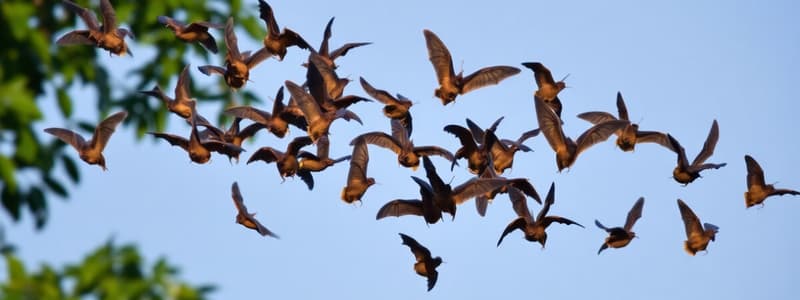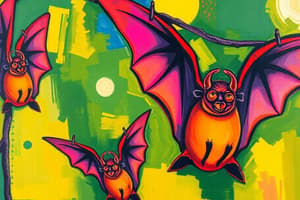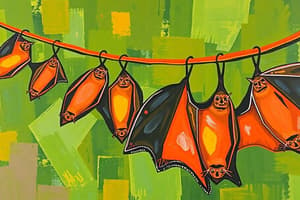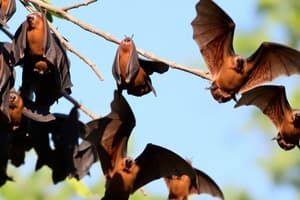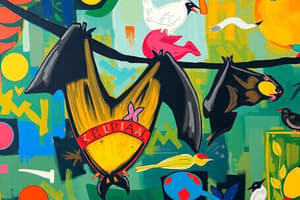Podcast
Questions and Answers
What is the primary motivation for the straw-colored fruit bats migrating to Kasanka National Park?
What is the primary motivation for the straw-colored fruit bats migrating to Kasanka National Park?
- To escape harsh weather conditions
- To find suitable nesting grounds
- To breed
- To access a plentiful food source (correct)
According to the provided information, how long does the annual migration of straw-colored fruit bats to Kasanka last?
According to the provided information, how long does the annual migration of straw-colored fruit bats to Kasanka last?
- Three months (correct)
- Two months
- Six months
- Twelve months
What evidence suggests that mating is not the primary reason for the bats' migration to Kasanka?
What evidence suggests that mating is not the primary reason for the bats' migration to Kasanka?
- The bats are known to mate in other African countries. (correct)
- The bats are known to feast on wild fruits in surrounding farmlands.
- Kasanka is the smallest of 20 national parks in Zambia.
- The bats disperse and return to their habitats after a few months.
Based on the provided information, which of the following is a plausible reason why the bats choose Kasanka National Park for their migration?
Based on the provided information, which of the following is a plausible reason why the bats choose Kasanka National Park for their migration?
Using the provided data and the accompanying image, what can we infer about the straw-colored fruit bats?
Using the provided data and the accompanying image, what can we infer about the straw-colored fruit bats?
Which of the following provides the most plausible reason for the straw-colored fruit bats' limited three-month stay at Kasanka despite the availability of food year-round?
Which of the following provides the most plausible reason for the straw-colored fruit bats' limited three-month stay at Kasanka despite the availability of food year-round?
What does the text suggest is a primary challenge in conducting research on the straw-colored fruit bats' migration patterns?
What does the text suggest is a primary challenge in conducting research on the straw-colored fruit bats' migration patterns?
Which of the following statements best captures the central argument about the ecological significance of straw-colored fruit bats' migration?
Which of the following statements best captures the central argument about the ecological significance of straw-colored fruit bats' migration?
Which of these factors is NOT directly mentioned in the text as a threat to straw-colored fruit bat populations?
Which of these factors is NOT directly mentioned in the text as a threat to straw-colored fruit bat populations?
What inference can be drawn about the reason straw-colored fruit bats are considered highly effective seed dispersers?
What inference can be drawn about the reason straw-colored fruit bats are considered highly effective seed dispersers?
Given the information provided, which of these statements most accurately reflects the relationship between the straw-colored fruit bat colonies in Kasanka and the ecological impact of their presence?
Given the information provided, which of these statements most accurately reflects the relationship between the straw-colored fruit bat colonies in Kasanka and the ecological impact of their presence?
Based on the text, how do straw-colored fruit bats contribute to the preservation of plant species?
Based on the text, how do straw-colored fruit bats contribute to the preservation of plant species?
The text suggests that the decline in the straw-colored fruit bat population could have a significant impact on which of these aspects?
The text suggests that the decline in the straw-colored fruit bat population could have a significant impact on which of these aspects?
Flashcards
Kasanka National Park
Kasanka National Park
A national park in Zambia known for the world's largest mammal migration.
Straw-colored fruit bats
Straw-colored fruit bats
The species of bats that migrate to Kasanka, feeding on fruits.
Mammal migration
Mammal migration
Seasonal movement of mammals from one habitat to another, often for feeding.
Migration period
Migration period
Signup and view all the flashcards
Ambiguous reasons for migration
Ambiguous reasons for migration
Signup and view all the flashcards
Migration to Kasanka
Migration to Kasanka
Signup and view all the flashcards
Importance of bat migration
Importance of bat migration
Signup and view all the flashcards
Seed dispersal
Seed dispersal
Signup and view all the flashcards
Habitat threats
Habitat threats
Signup and view all the flashcards
Conservation importance
Conservation importance
Signup and view all the flashcards
Dr. Teague O'Mara
Dr. Teague O'Mara
Signup and view all the flashcards
Wingspan of bats
Wingspan of bats
Signup and view all the flashcards
